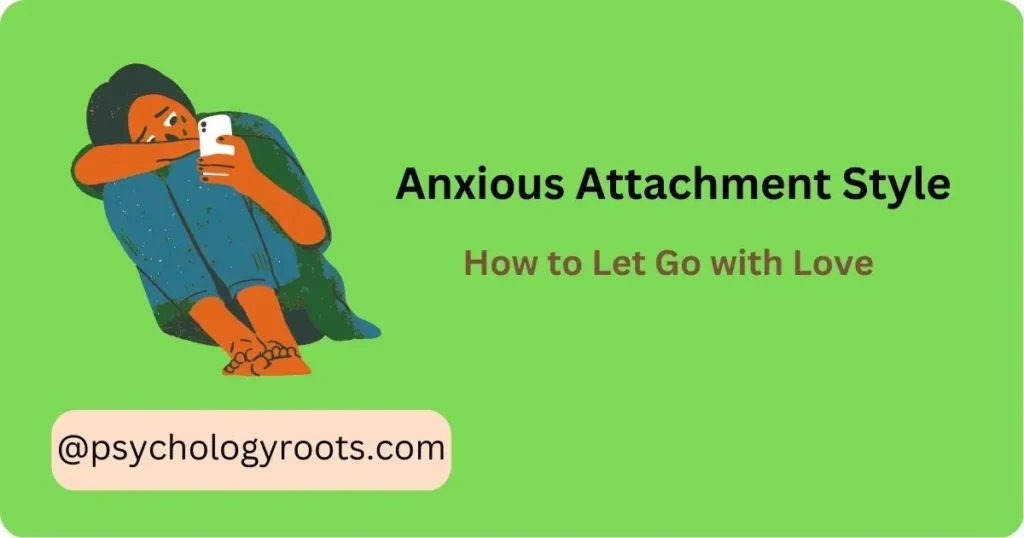Table of Contents
Breaking Free from Anxious Attachment Style: How to Let Go with Love
Here in this post, we are discussing “Breaking Free from Anxious Attachment Style: How to Let Go with Love”. You can read more about psychology-related material on our website. Keep visiting Psychology Roots.
Table of Contents
In relationships, it’s normal to want to feel close to someone and to have a sense of security and comfort with them. However, for some people, this desire for closeness can turn into an unhealthy attachment style known as anxious attachment. This attachment style can cause a lot of distress and interfere with the ability to form healthy relationships. In this blog post, we will explore the concept of anxious attachment, its impact on relationships, and most importantly, how to break free from it with love.

Understanding Anxious Attachment Style
Anxious attachment style is a type of insecure attachment that develops in childhood as a result of inconsistent or unpredictable parenting. This attachment style can lead to the development of negative beliefs about oneself and relationships, leading to a pattern of seeking reassurance and validation from others to alleviate feelings of anxiety and insecurity.
Here are some signs and symptoms of anxious attachment style:
- Constant need for reassurance and validation from others
- Fear of abandonment or rejection
- Over-analyzing and overthinking relationship interactions
- Jealousy and possessiveness
- Difficulty trusting others and oneself
- Overly emotional or dramatic reactions to relationship stressors
- Perfectionism and a fear of making mistakes
The causes of anxious attachment style are complex and can vary from person to person. Some common causes include inconsistent or unpredictable parenting, childhood trauma, and early experiences of rejection or abandonment.
Impact of Anxious Attachment Style
Anxious attachment style can have a significant impact on relationships. People with anxious attachment style may struggle to form and maintain healthy, stable relationships due to their intense need for reassurance and validation. This can create a cycle of insecurity and conflict in relationships, as their behaviors may be perceived as clingy or controlling by their partners. Here are some negative consequences of anxious attachment style:
Relationship Conflict: People with anxious attachment style may struggle with communication and conflict resolution skills, leading to frequent arguments and misunderstandings with their partners.
Emotional Distress: Anxious attachment style can lead to heightened emotional distress, such as anxiety, depression, and low self-esteem.
Self-Doubt: People with anxious attachment style may struggle with self-doubt, often questioning their worth and whether they are lovable or deserving of love.
Fear of Intimacy: The fear of intimacy can prevent people with anxious attachment style from fully engaging in relationships, as they may fear getting too close to someone and risking rejection or abandonment.
Negative Self-Fulfilling Prophecy: Anxious attachment style can create a self-fulfilling prophecy, where their anxious behaviors push their partners away, confirming their beliefs that they are unlovable or not good enough.
Strategies to Break Free from Anxious Attachment Style
Breaking free from anxious attachment style takes time and effort, but it is possible with the right strategies and support. Here are some strategies that can help:
Identify and Challenge Negative Thoughts: Anxious attachment style is often driven by negative beliefs and thought patterns about oneself and relationships. Recognizing these negative thoughts and actively challenging them with positive affirmations can help shift the mindset from fear and insecurity to self-love and acceptance.
Change Behavior Patterns: People with anxious attachment style often engage in behaviors that reinforce their anxious patterns, such as constantly seeking reassurance from their partners or avoiding vulnerability. Breaking these patterns and replacing them with healthier behaviors, such as practicing self-soothing techniques or expressing vulnerability, can help to shift attachment patterns.
Set Boundaries and Learn to Say No: Setting healthy boundaries is an important step in breaking free from anxious attachment style. This involves learning to say no to situations or relationships that do not align with personal values or needs, and being assertive in communication.
Practice Healthy Communication and Conflict Resolution Skills: Improving communication and conflict resolution skills can help to reduce relationship stress and improve overall relationship satisfaction. This involves active listening, empathizing, and expressing oneself in a clear and respectful manner.
Embrace Vulnerability and Take Risks: Anxious attachment style often involves a fear of vulnerability and taking risks in relationships. Learning to embrace vulnerability and take calculated risks can help to build trust and deepen connections with others.
Seek Professional Help: Breaking free from anxious attachment style can be challenging, and seeking professional help from a therapist or counselor can provide additional support and guidance. A therapist can help to identify patterns and provide strategies tailored to individual needs.
Help Us Improve This Article
Have you discovered an inaccuracy? We put out great effort to give accurate and scientifically trustworthy information to our readers. Please notify us if you discover any typographical or grammatical errors.
Make a comment. We acknowledge and appreciate your efforts.
If you have any scale or any material related to psychology kindly share it with us at psychologyroots@gmail.com. We help others on behalf of you.